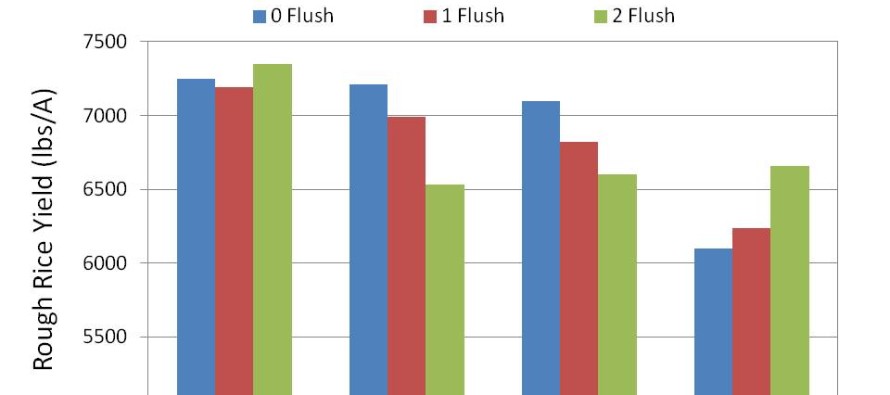How will rainfall impact seed treatments in soybeans, rice, cotton, and other crops?

With all of the rainfall that we have had throughout most of the state, there have been a lot of questions about the impact on seed treatments. In general, most of the seed treatments that are being used in all crops are water soluble. Typical levels of rainfall should not have a negative impact on the efficacy of seed treatments, but excessive rainfall may.
So the next question would be: What is excessive? Unfortunately none of us can answer that question. The impact of water on the efficacy of seed treatments is a topic that we don’t have a lot of data on, but one that we tend to speculate about a lot. We do have some data from one of our graduate students that just finished his M.S. degree looking at the impact of flushes in rice on the efficacy of seed treatments against rice water weevil. Mr. Andrew Adams planted rice treated with Dermacor, Cruiser, and Nipsit INSIDE. He had plots with each of those seed treatments that were not flushed, plots that were flushed one time, and plots that were flushed two times. The figure below shows the yields from that trial under moderate to heavy rice water weevil pressure.
What the research showed is that yields were negatively impacted where he flushed rice treated with either Cruiser or Nipsit INSIDE. Yields of rice that was treated with either Cruiser or Nipsit INSIDE and flushed 2 times were not significantly different than the untreated control. In contrast, yields for plots that were only flushed one time were significantly higher where Cruiser or Nipsit INSIDE were used compared to the untreated control, but yields were lower than where each of those seed treatments were not flushed.
What all of this tells us is that the neonicotinoid seed treatments can be negatively impacted by too much water and more water means more of an impact. This may or may not have anything to do with rainfall in other crops, but I do think we can make the general conclusion that the seed treatments have likely been negatively impacted in areas where we have gotten a lot of rainfall. In commercial fields, we do not have an untreated control for a comparison, but we can tell you from our research plots that the seed treatments are still working. In a cotton trial that I was looking at this morning, it was easy to find thrips and their damage behind all of the seed treatments. When we compared it to the untreated plots, the seed treatments actually looked pretty good. The problem is not that the seed treatments aren’t working, they just aren’t working as good as we would like them to.
In crops like soybean and cotton, it will be important to scout regularly and make foliar insecticide applications when needed. The need for scouting and insecticide applications will probably be more critical in cotton than in soybean because of it’s slow growth rate during the seedling stage. In cotton, it is important to remember that thrips can significantly delay maturity even if they don’t hurt yields. With the crop already being later than normal, it is going to be important for tarnished plant bug management later in the season to get the crop off to a good start.
In rice, the main pest that we target with seed treatments in Mississippi is the rice water weevil. As we get closer to flooding the fields, scout regularly and look for adult weevils and leaf scars from their feeding. Both Cruiser and Nipsit INSIDE provide good control of adult weevils and little adult feeding should be observed in fields with either of those seed treatments. The adult feeding generally will not impact yields, but it may be an indication that we have lost some of the efficacy with the seed treatments. Some leaf scars are normal because the adults have to feed a little before they die. When you see excessive feeding, it may be a good idea to make a supplemental foliar application to control the adults because we don’t have any good options once the larvae are on the roots.
In any of these situations, it is important to realize that the seed treatments are working and we would probably have a much worse situation if no seed treatment was used. The seed treatments do have tremendous value in all crops, because it becomes very difficult to control the early season pest complexes in any of these crops with foliar insecticides alone.





Let me tell You a sad story ! There are no comments yet, but You can be first one to comment this article.
Write a comment